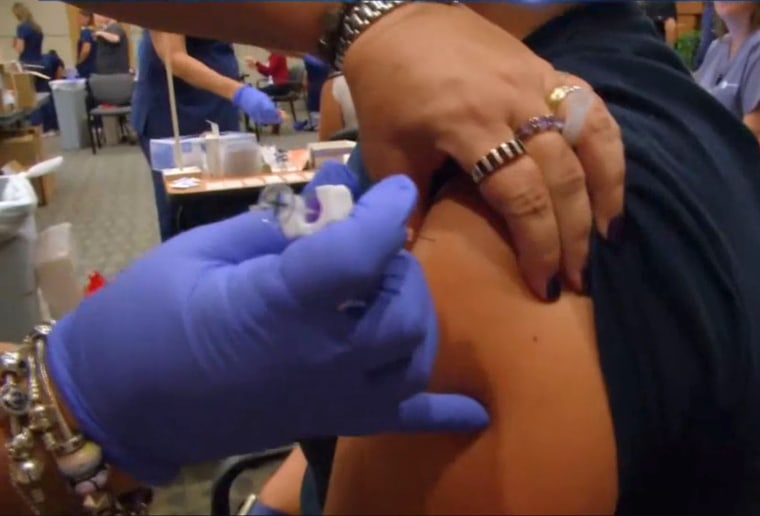It was pouring rain Thursday, so Cynthia Williams had to climb into the roving van that brought the flu vaccine team to her door.
Thirty seconds later, she was vaccinated and her fellow nurse-practitioner Carrie Dugan was slapping a bandage onto her arm. Williams, who works at one of the health system’s HIV clinics in Wilmington, Delaware was good to go, with only a few minutes taken out of her work day.
And she was one more down in Christiana Care Health System’s daylong blitz to try to vaccinate 12,000 staffers in one fell swoop.
“We’re trying to do it all in one day,” said Dr. Erin Meyer, a pediatric hospitalist with Christiana and the leader of the team in that particular roving van.
“If we can get them vaccinated now, you know that they can build immunity to the flu. We want our employees to be protected from the flu so they can better protect their patients. So we are doing a drive-by.”
Over the course of a very long day that stretched from 4 a.m. to 9 p.m., teams such as Meyer’s got flu shots into close to 7,800 employees. They hit 70 locations across four states, including Delaware, New Jersey, Pennsylvania and Maryland.
They are aiming for a vaccination rate of at least 95 percent. Last year, just 78 percent of health care staff were vaccinated against influenza, the Centers for Disease Control and Prevention reported.
The CDC says just about everyone needs a flu shot every year, but health care workers need them especially. Not only are they more likely to be exposed to flu, but they can transmit it to the very people they are supposed to be taking care of.
The least likely to be vaccinated were workers in long-term care facilities, where patients are extremely vulnerable to influenza.
Hospital systems are trying to get their numbers up, and some have begun mandating flu shots for workers. Christiana does not require it, but does require people to at least take part in a process and if they opt out of getting a flu vaccine, they need either a medical reason or must undergo education to help them understand the importance.
For the past few years, Christiana has managed to vaccinate more than 90 percent of staff, said Dr. Marci Drees, the health system’s infection prevention officer.
Getting 7,800 people done in a single day has gotten them ahead of schedule, she said. “The way we have done it before, it would take two to three weeks to get to the 7,000 or 8,000 mark,” Drees said.
“We have gotten a huge jump start.”
The system tried to turn the “Hit me with the flu shot” event into a party, playing music at hospitals and larger clinics where staffers lined up for their vaccines, providing photo booths for fun group shots and doing a live broadcast with a local radio station.

Smaller teams did hit-and-run visits, sometimes vaccinating a single staffer at smaller locations.
“We are having a blast,” Meyers said as she rode in the van from one location to the next, her colleagues whooping beside her.
“I think it generates an esprit de corps among the staff.”
Typically, physicians and nurses have the highest vaccination rates, but Meyer said the goal was to immunize every single person who works in the system’s network of hospitals, clinics and counseling centers.
“Custodians, patient escorts, nurses, respiratory therapists – we used them all as models and had them flex their arms. It wasn’t just doctors and nurses,” Meyer said. “We even want people in IT (information technology) to get it.”
The U.S. has poor flu vaccination rates. Just under half of Americans got a flu vaccine last year, the CDC said. Most who refuse it say they don’t think the vaccine is effective, but health experts say even if the vaccine only prevents about 40 to 60 percent of illnesses, it can help make sure that if people do catch the virus, they don’t end up in the hospital or die.
The last flu season was an especially deadly one. The CDC said 80,000 people died of flu and 900,000 ended up in the hospital –the highest number in decades. And 181 children died. Eighty percent of the kids who died had not been vaccinated, the CDC said.
Making it easier to get the vaccine can help encourage vaccination. Nicole Harrington, a specialty pharmacist who got her vaccine at the event Thursday, said it worked for her.
“I walked right in,” said Harrington, who was especially keen to be vaccinated because she is pregnant.
“It was extremely efficient.”
The exercise served a second purpose. If there was an outbreak of disease or a biological attack, the system has now had some practice at delivering vaccines or medications quickly and efficiently to front-line staff.
Vaccination will continue until the end of November, Drees said. Flu season usually peaks in the U.S. in January and February, but can start as early as October.

